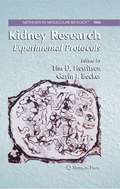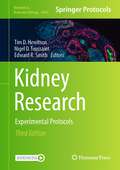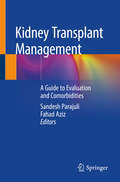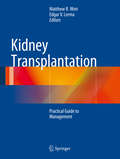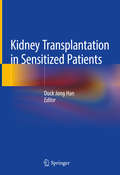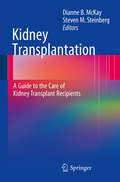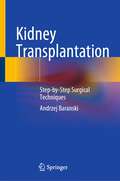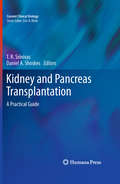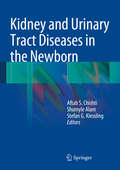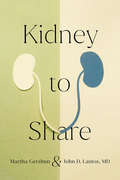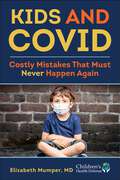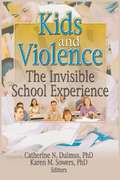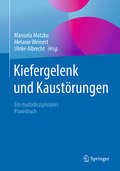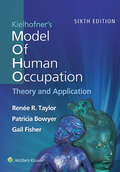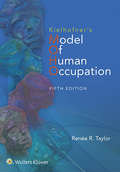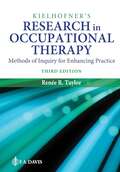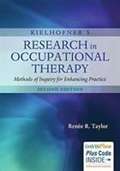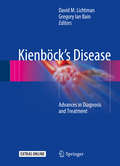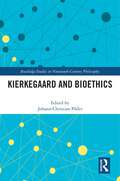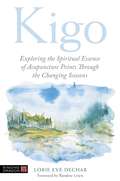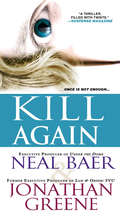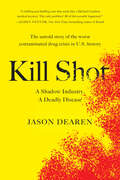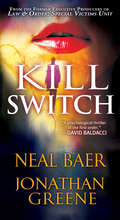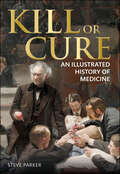- Table View
- List View
Kidney Research
by Tim D. Hewitson Gavin J. BeckerAs the expense of treating a growing number of end-stage kidney disease patients increases, greater attention has been paid to prevention and early treatment. The study of renal disease, however, suffers due to the complex nature of renal anatomy and physiology and the plethora of different cell types found in the kidney. In Kidney Research: Experimental Protocols, top experts in the field seek to aid researchers by providing a number of specialized techniques developed to examine this intricate system. Through both well-established and novel methods, this volume explores the preparation and culture of the main cell types used to study renal disease mechanisms, the common animal models used to mimic the various forms of human renal disease, and specific applications and techniques used in vivo and in vitro. Written in the highly successful Methods in Molecular BiologyTM series format, the chapters contain step-by-step, readily reproducible laboratory protocols, lists of the necessary materials and reagents, and tips on troubleshooting and avoiding known pitfalls. Essential and cutting-edge, Kidney Research: Experimental Protocols delivers invaluable guidance to new and experienced laboratory researchers delving into the sophisticated study of the kidney.
Kidney Research: Experimental Protocols (Methods in Molecular Biology #2664)
by Tim D. Hewitson Edward R. Smith Nigel D. ToussaintThis third edition provides updated and new chapters on recent innovations in basic renal research. Chapters are divided into three sections covering in vitro, in vivo, and ex vivo models of kidney disease, recent advances in imaging techniques and protocols for performing analytical and functional measurements in the kidney; techniques that are both topical and of widespread relevance to the study of kidney biology and disease. Written in the format of the highly successful Methods in Molecular Biology series, each chapter includes an introduction to the topic, lists necessary materials and methods, includes tips on troubleshooting and known pitfalls, and step-by-step, readily reproducible protocols. Authoritative and cutting-edge, Kidney Research: Experimental Protocols, Third Edition aims to be comprehensive guide for researchers in the field.
Kidney Transplant Management: A Guide To Evaluation And Comorbidities
by Sandesh Parajuli Fahad AzizThis concise book provides an overview of the essential aspects of transplant nephrology. Chapters cover patient evaluation, treatment options, complications and post kidney transplant approaches to various common chronic diseases. The importance of proper immunosuppressants adjustment to improve the graft half-life and overall patient quality of life are also highlighted. Up to date and practical, this book gives nephrologists and providers that treat kidney transplant patients a succinct resource on management.
Kidney Transplantation
by Edgar V. Lerma Matthew R. WeirWith the increased prevalence of kidney transplantation, transplant recipients are being treated in a variety of clinical settings - often beyond the transplant center. There is a greater need for clinicians and allied healthcare professionals to have appropriate guidance on managing these patients. Kidney Transplantation offers the latest evidence-based information on the full range of dilemmas in the medical management of kidney transplant recipients before, during and after transplantation. Beginning with the selection of patients who are candidates for transplantation, this authoritative guide covers the care of the patient on the waiting list and evaluation of donors, preoperative care, induction and immunosuppression maintenance. This wealth of new information and guidelines will serve as an important resource for the best possible care for transplant patients.
Kidney Transplantation in Sensitized Patients
by Duck Jong HanThis book presents state of the art knowledge on all aspects of kidney transplantation in recipients in whom desensitization strategies are necessary in order to overcome immunologic barriers such as anti-human leukocyte antigen (HLA) donor-specific antibody and ABO blood group incompatibility. Readers will find detailed, up-to-date information on the various immunomodulating therapies that may be employed in these circumstances and the outcomes that may be expected. Full guidance is provided on preoperative evaluation and management and post-transplantation care. In addition, the pathology of antibody-mediated rejection and acute cellular rejection in this context is discussed. For most patients with end-stage renal disease, kidney transplantation offers significant benefits compared with dialysis, but especially sensitization to HLAs remains a major clinical obstacle to success. Kidney Transplantation in Sensitized Patients will assist in achieving optimal results in individual patients. It will be an important resource for everyone involved in the care of kidney transplant recipients.
Kidney Transplantation: A Guide to the Care of Kidney Transplant Recipients
by Dianne B. Mckay Steven M. SteinbergKidney Transplantation: A Guide to the Care of Transplant Recipients is an easy to read, up to date, clinical resource written by experts in the field of kidney transplantation. The book explains how donors and recipients are selected for transplantation, how the surgical procedure is performed, and how the experts recognize and treat rejection. Clearly illustrated chapters show how the immune system works in the setting of transplantation and how immunosuppressive medications prevent rejection of the transplanted kidney; knowledge essential for the proper care of the transplant recipient. The acute and long-term care of the patient is described from the perspective not only of proper immunosuppressive medication management, but also from the perspective of comorbidities most common to transplanted patients, including cardiovascular disease, diabetes mellitus, infectious diseases, malignancies, and bone disease. Special issues that impact the care of the transplant recipient, such as unusual donor sources, nonadherence and insurability are also addressed.
Kidney Transplantation: Step-by-Step Surgical Techniques
by Andrzej BaranskiThis book provides a practically applicable guide to the latest techniques in kidney transplantation in an easy-to-digest format. Background is provided on relevant aspects of anatomy and physiology. Detailed step-by-step procedural guidance describes how to successfully perform benching surgery, kidney transplantation and graftectomy techniques. Surgical methods of non-laparoscopic kidney procurement from deceased and living donors are also covered. Potential complications with relevant prevention and resolution strategies are discussed to assist the reader in developing a deep understanding of the methodologies presented. In this book, the author shares his knowledge and experience gained over 35 years in the field of kidney procurement, preparation and transplantation. The book is a monograph and contains many of the author's individual views on certain kidney procurement and transplantation techniques.Kidney Transplantation: Step-by-Step Surgical Techniques is a concise overview of techniques for kidney procurement, benching and transplantation. Therefore, it is a valuable resource for all practicing and trainee practitioners who encounter these patients in their day-to-day practice.
Kidney and Pancreas Transplantation
by Daniel A. Shoskes T. R. SrinivasThe transplant physicians and surgeons at Cleveland Clinic have collaborated to produce, Kidney and Pancreas Transplantation: A Practical Guide. This volume is devoted to kidney and pancreas transplantation and is well grounded in scientific principles, quantitative clinical reasoning, clinical pharmacology, tested clinical practices and overall clinical applicability. Also addressed are key aspects in the initiation, maintenance and sustained growth of viable clinical programs in kidney and pancreas transplantation. Kidney and Pancreas Transplantation: A Practical Guide will be of great value to transplant physicians as well as medical and surgical fellows who intend to pursue an interest in transplantation.
Kidney and Urinary Tract Diseases in the Newborn
by Aftab S. Chishti Shumyle Alam Stefan G. KiesslingThis book provides a comprehensive and up-to-date overview of all key issues related to kidney and urinary tract disease in full-term and premature newborns. Among the many topics addressed are fluid and electrolyte abnormalities, hydronephrosis, urinary tract infection, obstructive uropathy and renal replacement therapy. The approach throughout is clinically oriented, the aim being to provide the reader with hands-on guidance. Each chapter commences with a clinical case vignette and concludes with a take-home message highlighting key aspects of practical importance. In addition, however, informative reviews of the literature and the basic sciences are included. No other book currently on the market focuses solely on the newborn, and Kidney and Urinary Tract Diseases in the Newborn will be especially valuable to those undergoing fellowship training in neonatology or pediatric nephrology/urology.
Kidney to Share (The Culture and Politics of Health Care Work)
by Martha Gershun John D. LantosIn Kidney to Share, Martha Gershun tells the story of her decision to donate a kidney to a stranger. She takes readers through the complex process by which such donors are vetted to ensure that they are physically and psychologically fit to take the risk of a major operation. John D. Lantos, a physician and bioethicist, places Gershun's story in the larger context of the history of kidney transplantation and the ethical controversies that surround living donors. Together, they help readers understand the discoveries that made transplantation relatively safe and effective as well as the legal, ethical, and economic policies that make it feasible. Gershun and Lantos explore the steps involved in recovering and allocating organs. They analyze the differences that arise depending on whether the organ comes from a living donor or one who has died. They observe the expertise—and the shortcomings—of doctors, nurses, and other professionals and describe the burdens that we place on people who are willing to donate. In this raw and vivid book, Gershun and Lantos ask us to consider just how far society should go in using one person's healthy body parts in order to save another person.Kidney to Share provides an account of organ donation that is both personal and analytical. The combination of perspectives leads to a profound and compelling exploration of a largely opaque practice. Gershun and Lantos pull back the curtain to offer readers a more transparent view of the fascinating world of organ donation.
Kids and COVID: Costly Mistakes That Must Never Happen Again
by Elizabeth MumperKids and COVID provides an in-depth look at mistakes pandemic officials made that hurt children and adolescents around the world. In spring of 2020, it was understandable that those directing government policies made errors of judgment since data was just emerging. However, within the first year of the declared pandemic, physicians and scientists from around the globe published data and made reliable observations that should have prompted a change of course. Dr. Elizabeth Mumper documents early warnings from eminent clinicians that repurposed drugs could be used to treat patients early, rather than waiting until they had trouble breathing, as advised. Sound epidemiological evidence suggested in March 2020 that the mortality rate of COVID was far less than was reported on mainstream news. Doctors in the trenches treating patients warned of the dangers of hospital protocols, including giving remdesivir with its high rate of kidney damage and omitting appropriate doses of short-term steroids. These scientists and clinicians were gaslighted and accused of spreading &“misinformation.&” The most vulnerable—the young and elderly—suffered massive psychological damage as their social networks were dismantled. Immune function changed as beneficial microbes were disrupted. You may be surprised that what you learn in this book is quite different from what you were told. Kids and COVID calls on parents to organize grassroots efforts on behalf of their children to make global shutdowns and prolonged school closures a &“one and done&” phenomenon.
Kids and Violence: The Invisible School Experience
by Catherine Dulmus Karen SowersImplement prevention interventions and policies to curb the cycle of violence in our schools!Kids and Violence: The Invisible School Experience examines overt and covert violence occurring in the school setting involving students, school personnel, and school policy, and highlights a level of violence that is often hidden, ignored, or subtly tolerated. This book provides the latest research findings on various issues of violence in our schools. It also shows what happens when the adults responsible for the well-being of our children are actually perpetrating violence, staying silent about violence, or upholding a system that supports a violent atmosphere.Kids and Violence is unique in its holistic and systemic approach of examining types of violence that are often overlooked or endorsed by school policies. The book includes 11 chapters focusing on issues such as bullying, school personnel&’s role in violence, and prevention programs. The contributors are experts in their fields and include professors, deans, and directors of university social work schools. Kids and Violence presents the results of an exploratory study that examines self-identified bullies and addresses issues of immediate and vital importance, including: bullying among students, grades 3-8, in a rural school district observations by school personnel on bullying among elementary and middle school students corporal punishment as a cultural norm in the United States and its impact on discipline in our schools solution-focused crisis intervention with adolescents bullying of children and other abuses of power by school personnel adolescent dating violence in the school setting and much more!It is time to stop the harmful cycle of violence in our schools. This valuable resource serves as a call for immediate action, showing social workers and policymakers how to provide leadership in researching, developing, and delivering empirically-based prevention interventions and policies.
Kiefergelenk und Kaustörungen: Ein multidisziplinäres Praxisbuch
by Manuela Motzko Melanie Weinert Ulrike AlbrechtVoraussetzung für eine adäquate Therapie und Behandlung von Störungen im craniomandibulären und orofazialen System ist das ganzheitliche Verständnis über die Funktionsweise des Kiefergelenkes und Kauapparates. Die erfahrenen Autoren zeigen anschaulich und konkret, welche therapeutischen Interventionen bei Patienten mit Störungen im craniomandibulären und orofazialen System möglich sind: • Anatomie und Physiologie der Zähne, des Kiefers und des Kauens• Biomechanische und funktionelle Einschränkungen• Möglichkeiten der Therapie wie Manuelle Therapie, Osteopathie, Tape-Anlage, zahnmedizinische Schienenversorgung und logopädische InterventionenZahlreiche Fotos und Tabellen helfen bei der Befunderhebung und Einschätzung der Störung. Ein praxisnahes Buch für alle Ärzte und Therapeuten, die Patienten mit Dysphagie behandeln: Therapeuten wie Logopäden, Ergotherapeuten und Physiotherapeuten sowie Osteopathen und Zahnärzte, Ärzte unterschiedlicher Fachrichtungen.
Kielhofner's Model of Human Occupation
by Gail Fisher Renee Taylor Patricia BowyerUpdated throughout with the latest research, Kielhofner’s Model of Human Occupation, 6th Edition, is the definitive resource on the theory and application of the most widely used model in occupational therapy today. A client-centered approach explores what motivates each individual, how they select occupations and establish everyday routines, and how environment influences occupational behavior. This revised 6th Edition reflects the current framework and incorporates the most up-to-date MOHO theory, research, and application practices to give users complete preparation for today’s client care challenges.
Kielhofner's Model of Human Occupation: Theory and Application
by Renee TaylorUpdated throughout with new research, this 5th Edition of Kielhofner’s Model of Human Occupation (MOHO) offers a complete presentation of the most widely used model in occupational therapy today. In the new edition, author Renée Taylor preserves Dr. Kielhofner’s original voice and contributions while updating MOHO concepts and their uses in today’s practice environment. Throughout the book, readers will see a client-centered approach used to explore what motivates each individual, how they select occupations and establish everyday routines, and how environment influences occupational behavior. The 5th Edition continues to deliver the latest in MOHO theory, research, and application to practice and adds much that is new, including new case studies that show how MOHO can address the real-life issues depicted and expanded resources that enhance teaching and learning.
Kielhofner's Research In Occupational Therapy: Methods Of Inquiry For Enhancing Practice
by Renee R. TaylorRenée Taylor and an international team of contributors carry on Gary Kielhofner’s innovative vision to demystify the research process and demonstrate that research is essential to occupational therapy practice. They present a comprehensive guide to conducting applied research in the field from qualitative, quantitative, and mixed perspectives for students and clinicians. You’ll begin with a grounding in conducting evidence-based practice in OT and an explanation of the six broad components of the research process. Then you will explore research designs, measurements, and statistical analysis for qualitative and quantitative studies. You’ll examine the steps and procedures required to conduct research and how research can be used to shape professional practice and improve patient care. Additional topics include needs assessment research, program evaluation research, mixed methods research, outcomes research for evidence-based practice, writing a literature review, and obtaining funding for research.
Kielhofner's Research In Occupational Therapy: Methods of Inquiry for Enhancing Practice (2nd Edition)
by Renee R. TaylorWith an international team of expert contributors, Renee Taylor carries on Gary Kielhofner's innovative work in the 2nd Edition of his comprehensive research methodologies text. This guide bridges the gap between theorists and practitioners. It focuses on the relevance and logic of research to provide a practical, demystified approach to conducting applied research in the field for graduate students and clinicians. You'll begin with an introduction to the nature and scope of research and its place in OT and then explore research designs, measurements, and statistical analysis for qualitative, quantitative, and mixed studies. You'll examine the steps and procedures required to conduct research and how research can be used to shape professional practice and improve patient care.
Kienböck’s Disease
by David M. Lichtman Gregory Ian BainCollecting and synthesizing all of the most recent literature on Kienb#65533;ck's disease from around the world, this comprehensive text aims to provide a more dynamic, nuanced treatment algorithm for this enigmatic condition. Part I consolidates the basic science on Kienb#65533;ck's and the lunate, including anatomy, pathology, biomechanics and etiology. Clinical assessment is covered in part II, including radiology, advanced imaging and arthroscopy. The natural history and progression of the condition in children, adults and the elderly is also presented. By far the largest section, part III describes the roles and methods of the various management strategies for Kienb#65533;ck's, from minimally invasive techniques to arthroscopic and arthroplastic procedures. The final chapter draws from all of these concepts, establishes a new algorithm and provides a direction for the future. Written and edited by leaders in the field, and including supplemental video features for select chapters, Kienb#65533;ck's Disease: Advances in Diagnosis and Treatment is a remarkable text that helps unlock this mysterious condition, and will be a valuable resource for hand and orthopedic surgeons, residents and trainees worldwide.
Kierkegaard and Bioethics (Routledge Studies in Nineteenth-Century Philosophy)
by Johann-Christian PõderThis book explores Kierkegaard’s significance for bioethics and discusses how Kierkegaard’s existential thinking can enrich and advance current bioethical debates. A bioethics inspired by Kierkegaard is not focused primarily on ethical codes, principles, or cases, but on the existential 'how' of our medical situation. Such a perspective focuses on the formative ethical experiences that an individual can have in relation to oneself and others when dealing with medical decisions, interventions, and information. The chapters in this volume explore questions like: What happens when medicine and bioethics meet Kierkegaard? How might Kierkegaard’s writings and thoughts contribute to contemporary issues in medicine? Do we need an existential turn in bioethics? They offer theoretical reflections on how Kierkegaard’s existential thinking might contribute to bioethics and apply Kierkegaardian concepts to debates on health and disease, predictive medicine and enhancement, mental illness and trauma, COVID-19, and gender identity. Kierkegaard and Bioethics will be of interest to scholars and advanced students working on Kierkegaard, bioethics, moral philosophy, existential ethics, religious ethics, and the medical humanities.
Kierkegaard and Bioethics (Routledge Studies in Nineteenth-Century Philosophy)
by Johann-Christian PõderThis book explores Kierkegaard’s significance for bioethics and discusses how Kierkegaard’s existential thinking can enrich and advance current bioethical debates.A bioethics inspired by Kierkegaard is not focused primarily on ethical codes, principles, or cases, but on the existential 'how' of our medical situation. Such a perspective focuses on the formative ethical experiences that an individual can have in relation to oneself and others when dealing with medical decisions, interventions, and information. The chapters in this volume explore questions like: What happens when medicine and bioethics meet Kierkegaard? How might Kierkegaard’s writings and thoughts contribute to contemporary issues in medicine? Do we need an existential turn in bioethics? They offer theoretical reflections on how Kierkegaard’s existential thinking might contribute to bioethics and apply Kierkegaardian concepts to debates on health and disease, predictive medicine and enhancement, mental illness and trauma, COVID-19, and gender identity.Kierkegaard and Bioethics will be of interest to scholars and advanced students working on Kierkegaard, bioethics, moral philosophy, existential ethics, religious ethics, and the medical humanities.
Kigo: Exploring the Spiritual Essence of Acupuncture Points Through the Changing Seasons
by Lorie Eve DecharWith references to traditional Taoist and Chinese texts, as well as influences from the author's background in psychology and psychotherapy, this book by Lorie Dechar demonstrates how practitioners can work with the spirit of acupuncture points in modern practice. The concept of 'kigo', a Japanese word meaning 'season word', is used to understand the seasonal energy of the points and how the body relates to the universal flow. As an understanding of the spirit of the point brings focus and potency to a practitioner's needling, it also strengthens their ability to touch a patient's soul and spirit, besides the physical body.Tying in the macro cosmic connection of the body to the universe with a poetic force that amplifies and deepens the effect of acupuncture, Kigo is the perfect companion not only for acupuncturists, but also for chiropractors and psychotherapists, doctors and nurses, and other practitioners who use the points as part of their clinical work.
Kill Again (A Claire Waters Thriller #2)
by Neal Baer Jonathan Greene"So entertaining that you should think twice about using it for a bedtime read." --Suspense MagazineHaunted by a brutal childhood, forensic psychiatrist Dr. Claire Waters finds solace in helping other survivors of abuse. Her favorite patient, Rosa Sanchez, is finally getting her life together. So it's a shock when Rosa is handcuffed and led away by a man Claire assumes is law enforcement. But as Claire soon realizes, Rosa has been abducted.Claire turns to her friend Nick Lawler, a homicide detective in the NYPD. Nick will have to risk his career to find Rosa--and a deranged criminal who reduces his victims to nothing but bones. A brilliant gamesman, the killer has been preparing for this moment all of his life--when every letter is in place, every piece is in play--and the object of his obsession, Dr. Claire Waters, is in the game. Win, lose, or die . . .Praise for Neal Baer and Jonathan Greene's Kill Switch"A prime-time thriller . . . suspense on the order of Silence of the Lambs." --Denver Post"A psychological thriller of the first order." --David Baldacci"Masterful, unforgettable, gripping." --Douglas Preston"Riveting and rich with character." --Gayle Lynds"A fast-paced, gritty crime thriller from two great storytellers." --Christopher Meloni
Kill Shot: A Shadow Industry, a Deadly Disease
by Jason DearenAn award-winning investigative journalist's horrifying true crime story of America's deadliest drug contamination outbreak and the greed and deception that fueled it. Two pharmacists sit in a Boston courtroom accused of murder. The weapon: the fungus Exserohilum rostratum. The death count: 100 and rising. Kill Shot is the story of their hubris and fraud, discovered by a team of medical detectives who raced against the clock to hunt the killers and the fungal meningitis they'd unleashed."Bloodthirsty" is how doctors described the fungal microbe that contaminated thousands of drug vials produced by the New England Compounding Center (NECC). Though NECC chief Barry Cadden called his company the "Ferrari of Compounders," it was a slapdash operation of unqualified staff, mold-ridden lab surfaces, and hastily made medications that were injected into approximately 14,000 people. Once inside some of its human hosts, the fungus traveled through the tough tissue around the spine and wormed upward to the "deep brain," our control center for balance, breath, and the vital motor functions of life.Now, investigative journalist Jason Dearen turns a spotlight on this tragedy--the victims, the heroes, and the perpetrators--and the legal loopholes that allowed it to occur. Kill Shot forces a powerful but unchecked industry out of the shadows.
Kill Switch (A Claire Waters Thriller #1)
by Neal Baer Jonathan GreeneA prime-time thriller. . . suspense on the order of Silence of the Lambs. --Denver PostHaunted by a disturbing childhood incident, Dr. Claire Waters is drawn to those "untreatable" patients who seem to have no conscience or fear. In a holding cell at Rikers Island, where the young forensic psychiatrist meets with a dangerous inmate whose boyish looks mask a sordid history of violence, her daring methods reveal a key to her own dark past. And when the case propels her into the mind of a homicidal maniac watching her every move, the only way to stop a killer from killing again is to go beyond the edge of reason..."A psychological thriller of the first order."--David Baldacci "A high-octane, intricate thriller, delivered with skill." --Publishers Weekly"A startling, intense suspense novel that will have readers staying up at night--with the light on." --Suspense Magazine"A masterful thriller. Highly recommended." --Douglas Preston"A non-stop thrill ride." --Michael Palmer"Riveting psychological suspense." --Gayle Lynds"A masterful thriller. Highly recommended." --Douglas Preston"Exciting, fast-paced, filled with twists." --The Mystery Gazette"Keeps the reader engrossed and guessing." --Bookreporter.com"Suspenseful." --Booklist"A fast-paced, gritty crime thriller." --Christopher Meloni"Will keep you on the edge of your seat. " --Ice-T "An end you'll never see coming." --Mariska Hargitay
Kill or Cure: An Illustrated History of Medicine (DK Short Histories)
by Steve ParkerTelling the compelling stories behind mankind's never-ending quest to cure every disease, Kill or Cure uses an all-new format — a text-rich narrative combined with DK's beautiful visual design — to trace the extraordinary history of medicine. Beginning with early healers, chance discoveries, technological advancement, and "wonder" drugs, and using panels, timelines, and thematic spreads, Kill or Cure highlights information about human anatomy, surgical instruments, and medical breakthroughs while telling the dramatic tale of medical progress. Diaries, notebooks, and other first-person accounts tell the fascinating stories from the perspective of people who witnessed medical history firsthand.
